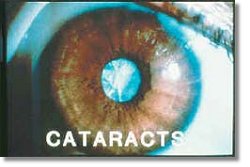Dr. Keith Seidenberg cares for his patients before, during and after surgery. He prides himself on the fact that patient care does not resemble an assembly line and that he and his staff provide all of their patients with caring, personal attention. Click here for more information about Dr. Seidenberg and his staff.
CATARACT
The purpose of this web page is to help you better understand what a cataract is, how it can affect your vision, and how it can be treated. We hope that this information will answer most of your questions and ease your concerns. Please feel free to discuss with us any questions or concerns that remain after reading this information.
What is a Cataract?
How Fast Does A Cataract Grow?
What Are The Causes Of Cataracts?
What Are The Symptoms Of Cataracts?
When Should A Cataract Be Removed?
How Are Cataracts Treated?
How Does Dr. Seidenberg Remove Cataracts?
What Is A Secondary Cataract?
What is a Cataract?
 A cataract is a clouding of the normally clear, transparent lens of the eye. A cataract is not a tumor or growth of new tissue over or in the eye. Rather it is a fogging and loss of clarity of the lens itself. The lens is located in the eye just behind the iris and the pupil. Light entering the eye is focused by the lens onto the retina. When a cataract forms, the lens is no longer able to focus the light clearly. Therefore, your vision becomes cloudy. An early cataract may cause few problems with vision. If the cataract gets worse, sight can be partially or completely lost until the cataract is removed.
A cataract is a clouding of the normally clear, transparent lens of the eye. A cataract is not a tumor or growth of new tissue over or in the eye. Rather it is a fogging and loss of clarity of the lens itself. The lens is located in the eye just behind the iris and the pupil. Light entering the eye is focused by the lens onto the retina. When a cataract forms, the lens is no longer able to focus the light clearly. Therefore, your vision becomes cloudy. An early cataract may cause few problems with vision. If the cataract gets worse, sight can be partially or completely lost until the cataract is removed.
How Fast Does A Cataract Grow?
Certain types of cataracts progress quite rapidly and cause cloudy vision within a few months. Fortunately, these are relatively uncommon. Most cataracts develop gradually and do not require surgery for many months or years. In some instances, surgery is never required.
What Are The Causes Of Cataracts?
There are many types of cataracts. Most are caused by chemical changes in the lens that partially result from the normal process of aging. These cataracts can rarely occur as early as age 30. There is now evidence that prolonged exposure to ultraviolet light can contribute to cataract formation. Ultraviolet light is a normal, invisible component of sunlight. Most exposure to ultraviolet light occurs outdoors between 10:00 a.m. and 2:00 p.m., particularly in the summer season. Exposure to ultraviolet light can be reduced by wearing a hat with a brim and glasses that filter out ultraviolet light. Other causes of cataracts include eye injuries and certain infections or diseases such as diabetes. There is new preliminary information that suggests that mild forms of vitamin deficiency can contribute to cataract formation. For this reason, it may be prudent to take one multivitamin per day. There is no evidence that taking large doses of vitamins provides any benefit. In rare instances, children can develop cataracts. If these are present at birth, they are called congenital cataracts.
 What Are The Symptoms Of Cataracts?
What Are The Symptoms Of Cataracts?
The most common symptom of a cataract is cloudy or blurred vision. Some people notice a haziness or cloudiness of their vision, as if their glasses are constantly in need of cleaning. Double vision can occur as the cataract is forming. Glare or sensitivity to bright lights is another common complaint; at night, there may be haloes around lights or scattering of the light from the headlights of oncoming cars. Some cataracts first affect reading or other types of close work. Other types of cataracts initially interfere with driving or seeing at a distance. Sometimes changing the glasses is helpful in restoring good vision. However, as the cataract worsens, stronger glasses may no longer improve sight.
When Should A Cataract Be Removed?
The appropriate time for cataract surgery depends upon the severity of your cataract and the degree to which it interferes with your normal daily activities. Selecting the right time for cataract surgery is a personal decision. If you are very active and use your eyes extensively for detailed work, you might benefit from cataract removal at an earlier stage than someone with less critical visual needs.
How Are Cataracts Treated?
At present the only treatment for a cataract is surgery to remove it. Many other remedies for cataracts have been attempted. These have included medications, eye drops, vitamins, changes in diet, and resting the eyes. Unfortunately, none of these has proven successful in dissolving or clearing cataracts. Fortunately, there have been tremendous advances in cataract surgery in the past several years. The chances for recovering good vision after surgery are now excellent. Due to recent advances, cataract surgery now causes remarkably little discomfort and inconvenience.
How Does Dr. Seidenberg Remove Cataracts?
Most cataracts will be removed with a procedure called phacoemulsification. First, a tiny incision of about 1/8 of an inch is made in the eye through which an ultrasonic probe is inserted. The ultrasonic probe creates sound waves that gently break up the cataract into tiny pieces and then suctions them out of the eye. Then, to replace the eye’s natural lens, a foldable intraocular lens (IOL) is permanently implanted into the eye through this tiny incision. Due to the architecture of this self-sealing incision, sutures are
 rarely necessary.
rarely necessary.
What Is A Secondary Cataract?
During cataract surgery a clear capsule is left in place in support the lens implant. In some cases this capsule may turn cloudy months or years after surgery creating a “secondary” cataract. A quick and painless laser procedure will quickly restore good vision.
Conclusion
There have been remarkable advances in cataract surgery in the past several years. We have gone from the time when people needed to lie still in bed for six weeks to an era in which outstanding vision is usually restored, often within a week or two. We look forward to discussing any of these matters further with you.